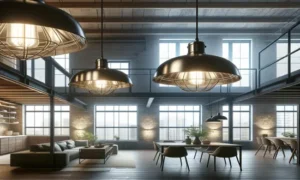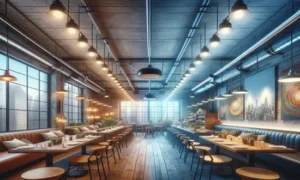Introduction
Lighting is a fundamental element in architecture and interior design, playing a crucial role in defining the atmosphere and style of a room. Among the various approaches available, industrial lighting stands out for its ability to transform spaces with a unique charm and contemporary aura. This style, which originally found its roots in industrial spaces and factories, has transcended its original environment to become a coveted trend in modern interior design. By balancing robust functionality with minimalist aesthetics, industrial lighting not only illuminates but also adds a distinctive character to any space. In this article, we will discuss the fascinating world of industrial lighting, unraveling the secrets behind its growing popularity and how it can be used to create unique and immersive environments.
What is Industrial Lighting?
Industrial lighting, as the name suggests, has its origins in industrial settings such as factories and warehouses in the early 20th century. Characterized by its rugged and practical appearance, this form of lighting was originally designed to be functional, durable and efficient, suitable for withstanding the harsh conditions of these workplaces. Over time, these utilitarian features have been reimagined and adapted for interior design, where they now play a more aesthetic role.
The evolution of industrial lighting reflects a broader shift in interior design trends. Over the past few decades, there has been a growing appreciation for the rustic charm and simplicity of industrial pieces, fueled by a movement towards more authentic, raw designs. This has led to the popularization of industrial-style lighting fixtures in a range of spaces, from urban lofts and cafes to modern offices and homes. Distinguishing features of industrial lighting include the use of heavy metals such as iron and steel, clean lines and geometric shapes, and a color palette often dominated by neutrals and metallics. These elements combine to create an aesthetic that is at once nostalgic and avant-garde, infusing a sense of history and character into contemporary settings.
Key Elements of Industrial Lighting
When exploring the world of industrial lighting, it is essential to understand the key elements that define this style. The choice of fixtures and materials not only determines the functionality of the light, but also contributes significantly to the overall aesthetics of the space.
Types of Lighting Fixtures and Materials Used: Industrial lighting fixtures are often made from robust metals such as iron, steel or aluminum, offering durability and a look that harks back to industrial heritage. In addition to metals, glass and wood are also common, adding a dimension of warmth and texture to the design. Lighting fixtures range from pendants and spotlights to track and wall lights. Each type has a specific purpose: while pendants are perfect for creating a focal point or illuminating accent areas, spotlights and track lights offer more directional and adjustable lighting.
Aesthetic and Functional Characteristics: Aesthetically, industrial lighting stands out for its clean lines, geometric shapes and minimalist color palette, often with black, white or metal finishes. Functionally, these fixtures are designed to maximize lighting efficiency, with reflectors and shades directing light to specific areas. The robust nature of industrial lighting also means that they are often durable and low-maintenance.
Influence on the Environment: Industrial lighting has a profound impact on the ambiance of a space. Stylistically, it can transform an ordinary space into a sophisticated, modern setting, evoking a sense of rustic elegance. Functionally, strategic placement of lighting fixtures can highlight architectural features, create points of visual interest, and define different areas within a larger space. Additionally, the type of bulb you choose, whether LED, incandescent, or fluorescent, can influence the tone and atmosphere of a space, from a warm, welcoming glow to a brighter, more stimulating light.
By incorporating these elements into a design, industrial lighting not only illuminates a space, but also becomes a centerpiece of the room's style and personality.
How Industrial Lighting Can Transform Spaces
Industrial lighting is more than just a stylistic choice; it is a powerful tool for transforming spaces. Through practical examples and case studies, we can see how this design approach has the potential to redefine environments, creating unique and vibrant atmospheres.
Transforming an Urban Loft: Consider an urban loft with a minimalist interior design. Originally, the space was lit by generic light fixtures, offering functionality but little in the way of style or character. The introduction of industrial-style pendant lights, with their robust lines and brushed metal finish, instantly changed the dynamic of the space. Not only did the lights provide more focused lighting over key areas like the dining room and kitchen, but they also added an architectural element that complemented the exposed beams and exposed brick. The result was a space that perfectly balances modern with industrial, creating a welcoming and aesthetically pleasing ambiance.
Revitalizing a Restaurant: A downtown restaurant looking to update its ambiance decided to incorporate industrial lighting. Before the renovation, the restaurant had soft, diffuse lighting that, while welcoming, did not do justice to its rustic décor and contemporary artwork. Installing industrial track lights, along with pendant lights above the tables, transformed the space. The new lighting highlighted the art walls and created a play of light and shadow that added depth and visual interest to the space, drawing more customers in with its updated, vibrant ambiance.
Reimagining a Shared Workspace: In a co-working space focused on creativity and collaboration, industrial lighting served as a unifying element. The space was originally lit by fluorescent fixtures, which, while efficient, provided little inspiration. Replacing them with a combination of industrial pendant lights and spotlights created a more dynamic and adaptive lighting experience. Individual work areas were given directional lighting to improve concentration, while communal areas were accented with softer lighting, encouraging interaction and the exchange of ideas. The change not only improved the functionality of the space, but also reinforced the visual identity of the location as a hub for innovation and creativity.
Each of these examples illustrates how effective industrial lighting can be in transforming a space. By changing the way a space is lit, you can fundamentally alter its perception, functionality and aesthetic appeal, transforming ordinary spaces into extraordinary experiences.
Tips for Creating Unique Environments with Industrial Lighting
Creating a unique environment with industrial lighting requires a keen eye for detail and an understanding of how light interacts with space. Here are some practical tips:
- Balance between Form and Function: Choose lighting fixtures that not only complement the aesthetics of your space but also provide the necessary illumination. For example, industrial pendant lights are great for creating a focal point, while spotlights and track lights can be used to illuminate work areas or display artwork.
- Play with Heights and Levels: Different heights of light fixtures can add dynamics and depth to your space. Consider hanging light fixtures at different heights or using floor lamps to create layers of light.
- Integration with Other Decorative Elements: Industrial lighting works well with a variety of decor styles. For example, in a space with exposed brick or concrete, metal fixtures can enhance the rustic charm. In more modern settings, opt for fixtures with clean lines and minimalist finishes.
- Light Control: Use dimmers to adjust the intensity of the light, creating different atmospheres as needed. This not only adds versatility to your space, but can also be helpful in saving energy.
Implementation Challenges and Considerations
When implementing industrial lighting, some challenges and considerations must be taken into account:
- Installation: Installing industrial lighting fixtures can be more complex due to their weight and size. It is important to ensure that the ceiling or wall can support the weight of the fixtures. In some cases, it may be necessary to seek professional help for installation.
- Maintenance: Due to their robust characteristics, many industrial luminaires are low maintenance. However, it is vital to regularly check electrical connections and material integrity to ensure safety and durability.
- Energy Safety and Efficiency: When choosing light fixtures and bulbs, consider energy efficiency and safety standards. LED bulbs, for example, are not only more energy efficient, but they also generate less heat, reducing the risk of accidents and contributing to a more sustainable environment.
Future Trends in Industrial Lighting
Future trends in industrial lighting are leaning towards the incorporation of sustainable and smart technologies. The integration of automated lighting control systems, which allow for the customization of light in terms of intensity and color, is becoming increasingly popular. In addition, sustainability is a major driving force, with a growing focus on the use of recycled materials and the energy efficiency of lamps, especially LEDs. These innovations not only offer functional and environmental benefits, but also open up new horizons in interior design, allowing the creation of even more personalized and dynamic environments.
Conclusion
In short, industrial lighting offers a unique combination of style, functionality and versatility. Whether it’s transforming spaces, combining with different decorative styles, or adapting to future trends, it presents endless possibilities for creating unique environments. We encourage you to explore and experiment with industrial lighting to bring your spaces to life in new and exciting ways.



